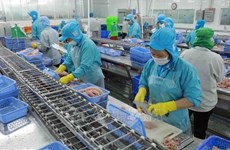Flower trade is blooming tough
Despite being renowned for high quality flowers, the Central Highlands province of Lam Dong still faces problems such as poor storage and lack of new, high quality seeds that hinder its ability to satisfy domestic demand.
 A flower farm in Lam Dong province. (Photo: VNA)
A flower farm in Lam Dong province. (Photo: VNA)Lam Dong (VNS/VNA) -
Despite being renowned for high quality flowers, the Central Highlands province
of Lam Dong still faces problems such as poor storage and lack of new, high
quality seeds that hinder its ability to satisfy domestic demand.
Lam Dong is the largest flower producer in Vietnam, supplying three billion branches per year, or 50 percent of the country’s output, accounting for 40 percent of the country’s flower growing area.
The province’s net houses and glasshouses, which improve flower growing, cover a total of 2,000ha.
However, most of the high-value flowers in the city are imported. The country imported 18 million USD of flowers for Lunar New Year 2018.
A representative from the Da Lat Flower Association said that many local age-old flowers had degraded in quality, and many have no copyright.
Universities and research facilities have not been able to satisfy demands for cross breeding and development of new flower types, according to the association.
The province, despite being famous for flower growing, has to buy seeds from other sources to grow high quality flowers, and Vietnamese regulations on importing new seeds are riddled with complicated procedures, leading to a lack of new seeds.
Only a number of foreign companies have large farming areas and are able to use modern machinery. In addition, farmers do not conduct market research on demand or price, and have to rely on intermediaries.
Nguyen Van Bao, Director of Dalat Hasfarm Co. Ltd (specialising in fresh flowers), said that most farmers still packed harvested flowers into small bundles, stored them in carton boxes, and transported them by truck, which can dry and damage flowers.
Technologies to store flowers for exporting are important. A lack of standards for domestic flowers results in inconsistent quality, the association said.
With a 15 percent annual growth in flower output, the Lam Dong flower industry has far more advantages compared to other provinces, and its flowers are popular in foreign markets such as Japan, Taiwan and China. Its export potential is still promising, the association noted.
Better cooperation is needed between businesses, the state, researchers and farmers, experts said. More policies to help businesses import new seeds as well as support for technologies and in tax and land matters are also important.
In addition, farmers should be encouraged to work with co-operatives and businesses to improve competitiveness.
Lam Dong is working with the Japan International Cooperation Agency to build a flower trading centre in Da Lat, which would allow for the transaction of 2.5 million flower branches on peak days. It will also provide better flower storage and improve transparency and trust between buyers and sellers.-VNS/VNA
Lam Dong is the largest flower producer in Vietnam, supplying three billion branches per year, or 50 percent of the country’s output, accounting for 40 percent of the country’s flower growing area.
The province’s net houses and glasshouses, which improve flower growing, cover a total of 2,000ha.
However, most of the high-value flowers in the city are imported. The country imported 18 million USD of flowers for Lunar New Year 2018.
A representative from the Da Lat Flower Association said that many local age-old flowers had degraded in quality, and many have no copyright.
Universities and research facilities have not been able to satisfy demands for cross breeding and development of new flower types, according to the association.
The province, despite being famous for flower growing, has to buy seeds from other sources to grow high quality flowers, and Vietnamese regulations on importing new seeds are riddled with complicated procedures, leading to a lack of new seeds.
Only a number of foreign companies have large farming areas and are able to use modern machinery. In addition, farmers do not conduct market research on demand or price, and have to rely on intermediaries.
Nguyen Van Bao, Director of Dalat Hasfarm Co. Ltd (specialising in fresh flowers), said that most farmers still packed harvested flowers into small bundles, stored them in carton boxes, and transported them by truck, which can dry and damage flowers.
Technologies to store flowers for exporting are important. A lack of standards for domestic flowers results in inconsistent quality, the association said.
With a 15 percent annual growth in flower output, the Lam Dong flower industry has far more advantages compared to other provinces, and its flowers are popular in foreign markets such as Japan, Taiwan and China. Its export potential is still promising, the association noted.
Better cooperation is needed between businesses, the state, researchers and farmers, experts said. More policies to help businesses import new seeds as well as support for technologies and in tax and land matters are also important.
In addition, farmers should be encouraged to work with co-operatives and businesses to improve competitiveness.
Lam Dong is working with the Japan International Cooperation Agency to build a flower trading centre in Da Lat, which would allow for the transaction of 2.5 million flower branches on peak days. It will also provide better flower storage and improve transparency and trust between buyers and sellers.-VNS/VNA












